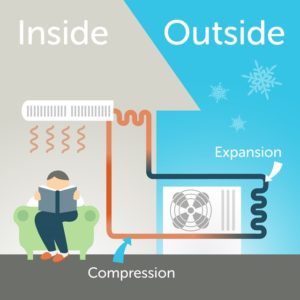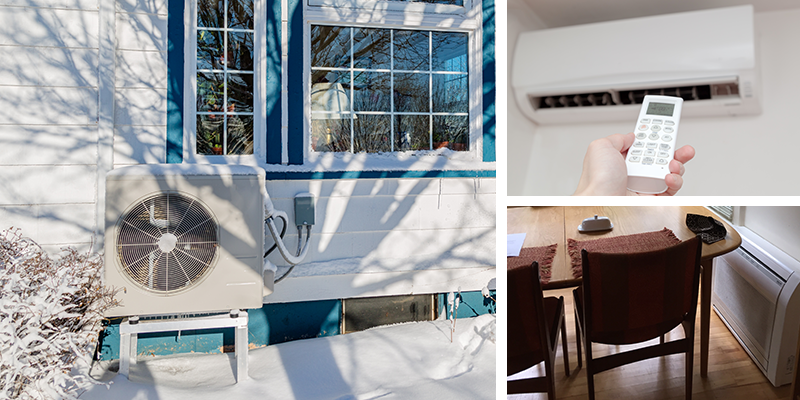Air source heat pumps (ASHP) are electric appliances that provide heating by moving heat into a building and cooling by moving heat out of a building. Heat pumps do not create heat through burning fossil fuels or through electric resistance like conventional heating systems.
Instead, they transfer heat from one place to another by using a refrigerant that absorbs heat from warmer air and moves the heat into space with colder air. This is similar to the way that a refrigerator or air conditioner works except that it can move heat in either direction to provide heating or cooling.
Because it takes far less energy to move heat than it does to create heat, ASHPs are much more efficient: ASHPs offer 2-4 times the heating efficiency of both fossil fuel furnaces and traditional electric resistance heat—and they can exceed the efficiency of window and central air conditioners as well.
Using cold climate air source heat pumps requires a slight shift in our thinking about how we heat our homes, especially for those of us used to simple on or off furnaces. The key is no longer expecting a blast of super hot air, but instead a constant gentle flow of the heat we need. Heat pumps are most efficient when they are making slight adjustments to the temperature, rather than big changes; evening setbacks should only be done for personal preference, not energy efficiency.
Learn more from NYSERDA:

Ductless air source systems can provide heating and air conditioning without the need for central ductwork. Each ductless system includes one outdoor unit connected to one (single-zone) or more (multi-zone) indoor wall, floor or ceiling air distribution units.
Ductless air source heat pumps are the most efficient air-source systems and can be installed as either a primary source of heating and cooling or to supplement existing systems. Some examples of these supplemental applications include:
Ductless indoor units come with remote controls (or smartphone apps!) that give you control over each unit and allow you to use them for heating, cooling, dehumidification or as a ceiling fan. Because each indoor unit can be controlled individually (forming an independent heating/cooling “zone”), you can heat or cool different zones in your home to different temperatures depending on personal comfort preferences—or reduce your energy use even more by turning down the unit in zones that are not being used.

Ducted systems have an outdoor unit that is connected to an air handler in a building’s ductwork, which is used to heat or cool the building. Ducted ASHPs are not much different from central air conditioners (they look similar too!), except that they provide heating and cooling in a single system. Ducted ASHPs can work with your home’s existing ductwork, though some modifications may be necessary to adapt it from being suited for a furnace or central AC to being suited for a heat pump.
Ducted air source heat pumps can also be installed in a “hybrid” or “dual-fuel” configuration, where the heat pump is connected with an existing or new furnace. When temperatures drop below a certain level, the furnace kicks in, and in the summer, the heat pump provides central air conditioning. This configuration automatically switches to the low-cost heating system based on outdoor air temperature and can be a great option for homeowners with existing ductwork that want to keep the existing furnace in place while saving on heating and cooling.